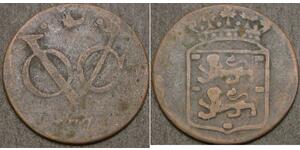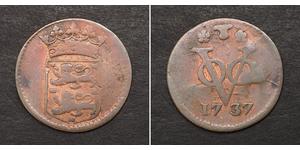(sold for $42.0)
1769, Parma, Maria Amalia of Austra. Silver Wedding to Ferdinand of Parma Medal.
Mint Years: 1769 Reference: Mont. 1999, CNI 2. Condition: Minor contact-marks and light wear, otherwise XF! Denomination: Medal - Wedding of Archduchess Maria Amalia of Austria with duke Ferdinand of Bourbon-Parma Diameter: 26mm Weight: 3.91gm Material: Silver
Obverse: Draped and jewelled bust of Archduchess Maria Amalia of Austria right. Legend: M . AMA . A . FERD - BOR . PARM .D . NVP .
Reverse: Two allegoric figures, flanking palm with two oval coat-of-arms. Legend: FELICI - NEXV Exergue: NVPT . CEL . VIND . PROC / FERD . A . A XXVII . IVN / MDCCLXIX
The Duchy of Parma was a small Italian state which existed between 1545 and 1802, and again from 1814 to 1860. The Duke of Parma was also Duke of Piacenza, except for the first years of the rule of Ottavio Farnese (1549–1556), and the time of the Napoleonic wars, when the two were established as separate positions held by two individuals. The Duke of Parma also usually held the title of Duke of Guastalla from 1735 (when Charles VI, Holy Roman Emperor took it from Mantua) to 1847 (when the territory was ceded to Modena), again, except for the Napoleonic dukes, when Napoleon's sister Pauline was Duchess of Guastalla and of Varella. The position is currently claimed by a member of the Bourbon family, which also holds the Spanish throne. Therefore, the current claimant to the Duchy of Parma is a legitimate (though not prime) claimant to the Kingdom of Spain; indeed, the recent pretender to the Parmese throne, the late Carlos-Hugo, was also a pretender to the Spanish throne in the 1970s (see Carlism).
Archduchess Maria Amalia of Austria (Maria Amalia Josepha Johanna Antonia; 26 February 1746 – 18 June 1804) was the Duchess of Parma, Piacenza and Guastalla by marriage. Maria Amalia was a daughter of Empress Maria Theresa and Emperor Francis I. She was thus younger sister to Joseph II, Holy Roman Emperor and older sister to Leopold II, Holy Roman Emperor, Maria Carolina, Queen of Naples and Marie Antoinette, Queen of France.
Ferdinand (20 January 1751 – 9 October 1802), baptised Ferdinand Maria Philip Louis Sebastian Francis James, was the Duke of Parma, Plasencia and Guastalla from his father's death on 18 July 1765 until he ceded the duchy to France by the Treaty of Aranjuez on 20 March 1801. He was a member of the Spanish House of Bourbon.
Born at the Ducal Palace of Colorno as the second child and only son of Philip, Duke of Parma, and Princess Louise Élisabeth of France, he was considered to be the favorite grandson of his maternal grandfather King Louis XV of France. As a grandson in the male line of King Philip V of Spain, he was also an infante of Spain. As a grandson of King Louis, Ferdinand was also a direct descendant of England's William the Conqueror.
As the heir to one of the largest collection of sovereign duchies, Ferdinand was an attractive candidate for many royal ladies of Europe. Probable candidates included the heiress Princess Maria Beatrice Ricciarda of Modena, daughter of Ercole III of Modena and (like Ferdinand) an in law of Marie Antoinette. His possible marriage to Princess Maria Beatrice was, however, very unlikely since the latter had been engaged to Archduke Leopold of Austria (later Emperor Leopold II)at a very young age and later on to Leopold's younger brother, Archduke Ferdinand, upon the death of an older brother, Archduke Charles. It is likely that a union between Parma and Modena was only promoted in vain by Parma's Minister, Du Tillot, since the engagement of Modena's heiress to an Austrian Archduke was already agreed very early on. Another candidate was Louise Marie Thérèse Bathilde d'Orléans who offered a very large dowry; she was the only surviving daughter of Louis Philippe I, Duke of Orléans. She was the sister of Philippe Égalité.
The decision of who his future spouse would be, was sealed by his mother's close correspondence with the powerful Empress Maria Theresa of Austria, who had promised Ferdinand's parents the throne of the Netherlands, which had been returned to Austrian rule under the Treaty of Aix-la-Chapelle. This never occurred and, as a result, an alliance with the Austrian Empire was used to cement the two nations. This alliance was also encouraged by the Parmese Prime Minister Guillaume du Tillot, who had worked at Versailles and had been exiled by Louis XV of France due to his liberal ideas, which were not looked upon with much enthusiasm by those at Versailles.
Guillaume du Tillot was again used during Ferdinand's reign when he lost his father in 1765 aged 14. Negotiations and ideas were passed from Vienna to Parma and in 1769, Ferdinand was to marry the Archduchess Maria Amalia of Austria; the eighth child of the Empress and older sister of the Queen of Naples and Sicily and the future Queen of France. Maria Amalia had a marriage by proxy in Vienna on 27 June and left her home on 1 July. The future duchess would meet her husband at Mantua on 16 July. His wife was with her brother Joseph II, Holy Roman Emperor and Ferdinand with members of the Sforza family. On 19 July there was a formal ceremony for all at the Ducal Palace of Colorno where Ferdinand had been born. During many festivities, the couple made their official entrance to Parma on 24 July. They had nine children in just under twenty years.
Ferdinand ceded the Duchy of Parma to France in the Treaty of Aranjuez (1801). The Treaty of Aranjuez was signed on 21 March 1801 between France and Spain. The overall accord confirmed the terms presented in the Treaty of San Ildefonso. Moreover, Ferdinand agreed to surrender the Duchy of Parma (with Piacenza and Guastalla) to France. Ferdinand's son Louis received the Grand Duchy of Tuscany, which became the Kingdom of Etruria. Ferdinand III, the Habsburg Grand Duke of Tuscany, was compensated with the secularized territories of the Archbishop of Salzburg.
He died in Parma at age 51, suspected to be poisoned although French authorities cited another reason for his death, and was buried in the church of Fontevivo Abbey. On his deathbed, however, he named a regency council with his wife Maria Amalia as its head, clearly still opposing the terms of the Treaty of Aranjuez regarding his duchy. The regency lasted only for days and the Duchy of Parma was annexed to France.
Only 1$ shipping for each additional coin purchased!

|
Posted by:
anonymous 2019-03-28 |
2 Liard Austrian Netherlands (1713-1795) Copper
group has 4 coins / 4 prices
⇑
1 Duit Netherlands Copper
group has 18 coins / 17 prices
⇑

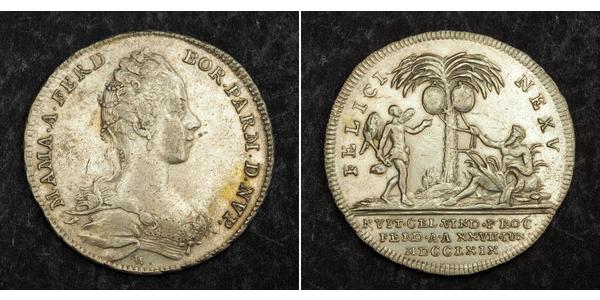










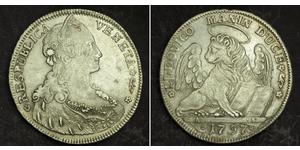
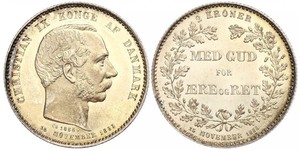


-300-150-N7QKX9ISGfEAAAFX9awaL_VH.jpg)

